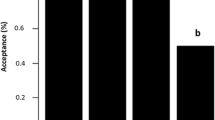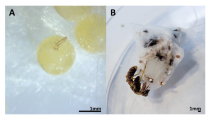Abstract
Portia fimbriata from Queensland, a previously studied jumping spider (Salticidae), routinely includes web-building spiders and cursorial salticids in its diet, both of these types of prey being dangerous and unusual prey for a salticid. The present paper is the first detailed study ofP. fimbriata's prey preferences. Three basic types of tests of prey preference were used, providing evidence that (1)P. fimbriata males and females prefer spiders (both web-building spiders in webs and salticids away from webs) to insects; (2)P. fimbriata males and females prefer salticids to web-building spiders; (3)P. fimbriata males and females prefer larger spiders to smaller spiders; (4) there are intersexual differences in the preferences ofP. fimbriata for prey size, females preferring larger prey and males preferring smaller prey; and (5)P. fimbriata's prey preferences are not affected by a prior period without food of 2 weeks. When preferences were tested for by using both living, active prey and dead, motionless lures, the same preferences were expressed, indicating thatP. fimbriata can distinguish among different types of prey independent of the different movement patterns of different prey.
Similar content being viewed by others
References
Blest, A. D., and Carter, M. (1987). Morphogenesis of a tiered principal retina and the evolution of jumping spiders.Nature 328: 152–155.
Blest, A. D., O'Carroll, D. C., and Carter, M. (1990). Comparative ultrastructure of Layer I receptor mosaics in principal eyes of jumping spiders: The evolution of regular arrays of light guides.Cell Tissue Res. 262: 445–460.
Bristowe, W. S. (1941).The Comity of Spiders 2; Ray Society, London.
Coddinton, J. A., and Levi, H. W. (1991). Systematics and evolution of spiders (Araneae).Annu. Rev. Ecol. Syst. 22: 565–592.
Curio, E. (1976).The Ethology of Predation, Springer-Verlag, Berlin.
Cutler, B. (1980). Ant predation byHabrocestum pulex (Hentz) (Araneae: Salticidae).Zool. Anz. 204: 97–101.
Dill, L. M. (1975). Predatory behavior of the zebra spider,Salticus scenicus (Araneae: Salticidae).Can. J. Zool. 53: 1284–1289.
Drees, O. (1952). Untersuchunger Über die angeborenen Verhaltensweisen bei Spingspinnen (Salticidae).Z. Tierpsychol. 9: 169–207.
Edwards, G. B., Carroll, J. F., and Whitcomb, W. H. (1974).Stoidis aurata (Araneae: Salticidae), a spider predator of ants.Fla. Entomol. 57: 337–346.
Foelix, R. F. (1982)Biology of Spiders, Harvard University Press, Cambridge, MA.
Forster, L. M. (1982). Visual communication in jumping spiders (Araneae: Salticidae). In Witt, P. N., and Rovner, J. S. (eds.),Spider Communication: Mechanisms and Ecological Significance, Princeton University Press, Princeton, NJ, pp. 161–212.
Forster, L. M. (1985). Target discrimination in jumping spiders (Araneae: Salticidae). In Barth, F. G. (ed.),Neurobiology of Arachnids, Springer-Verlag, Berlin, pp. 249–274.
Freed, A. N. (1984). Foraging behaviour in the jumping spiderPhidippus audax: Bases for selectivity.J. Zool. Lond. 202: 49–61.
Gardner, B. T. (1964). Hunger and sequential responses in the hunting behaviour of salticid spiders.J. Comp. Physiol. Psychol. 58: 167–173.
Givens, L. M. (1978). Dimorphic foraging strategies of a salticid spider (Phidippus audax).Ecology 59: 309–321.
Heil, K. H. (1936). Beiträge zur Physiologie und Psychologie der Springspinnen.Z. Vergl. Physiol. 23: 1–25.
Homann, H. (1928). Beträge zur Physiologie der Spinnenaugen. I. Untersuchungsmethoden, II. Das Sehvermöen der Salticiden.Z. Vergl. Physiol. 7: 201–268.
Jackson, R. R. (1982). The behavior of communicating in jumping spiders (Salticidae). In Witt, P. N., and Rovner, J. S. (eds.),Spider Communication: Mechanisms and Ecological Significance: Princeton University Press, Princeton, NJ, pp. 213–247.
Jackson, R. R. (1990a). Predatory versatility and intraspecific interactions ofCyrba algerina andC. ocellata, web-invading spartaeine jumping spiders (Araneae: Salticidae).N.Z. J. Zool. 17: 157–168.
Jackson, R. R. (1990b). Predatory and silk utilisation behaviour ofGelotia sp. indet. (Araneae: Salticidae), a web-invading aggressive mimic from Sri Lanka.N. Z. J. Zool. 17: 475–482.
Jackson, R. R. (1992). Eight-legged tricksters: Spiders that specialize in catching other spiders.BioScience 42: 590–598.
Jackson, R. R., and Blest, A. D. (1982a). The biology ofPortia fimbriata, a web-building jumping spider (Araneae: Salticidae) from Queensland: Utilization of webs and predatory versatility.J. Zool. Lond. 196: 255–293.
Jackson, R. R., and Blest, A. D. (1982b). The distances at which a primitive jumping spider,Portia fimbriata, makes visual discriminations.J. Exp. Biol. 97: 441–445.
Jackson, R. R., and Hallas, S. E. A. (1986a). Comparative biology ofPortia africana, P. albimana, P. fimbriata, P. labiata, andP. schultzi, araneophagic, web-building jumping spiders (Aranene: Salticidae): Utilisation of webs, predatory versatility, and intraspecific interactions.N. Z. J. Zool. 13: 423–489.
Jackson, R. R., and Hallas, S. E. A. (1986b). Predatory versatility and intraspecific interactions of spartaeine jumping spiders (Araneae: Salticidae):Brettus adonis, B. cingulatus, Cyrba algerina andPhaeacius spindet.N.Z. J. Zool. 13: 491–520.
Jackson, R. R., and Tarsitano, M. S. (1993). Responses of jumping spiders to motionless prey.Bull. Br. Arachnol. Soc. 9: 105–109.
Jackson, R. R., and van Olphen, A. (1991). Prey-capture techniques and prey preferences ofCorythalia canosa andPystira orbiculata, ant-eating jumping spiders (Araneae: Salticidae).J. Zool. Lond. 223: 577–591.
Jackson, R. R., and van Olphen, A. (1992). Prey-capture techniques and prey preferences ofChrysilla, Natta, andSiler, ant-eating jumping spiders (Araneae: Salticidae) from Kenya and Sri Lanka.J. Zool. Lond. 227: 163–170.
Land, M. F. (1969a). Structure of the retinae of the principal eyes of jumping spiders (Salticidae: Dendryphantinae) in relation to visual optics.J. Exp. Biol. 51: 443–470.
Land, M. F. (1969b). Movements of the retinae of jumping spiders (Salticidae) in response to visual stimuli.J. Exp. Biol. 51: 471–493.
Land, M. F. (1971). Orientation by jumping spiders in the absence of visual feedback.J. Exp. Biol. 54: 119–139.
Land, M. F. (1972). Stepping movements made by jumping spiders during turns mediated by the lateral eyes.J. Exp. Biol. 57: 15–40.
Land, M. F. (1974). A comparison of the visual behavior of a predatory arthropod with that of a mammal. In Wiersma, C. A. G. (ed.),Invertebrate Neurons and Behavior, Massachusetts Institute of Technology Press, Boston, pp. 411–418.
Nentwig, W. (1986). Non-webbuilding spiders: Prey specialists or generalists?Oecologia 69: 571–576.
Prószyński, J. (1971). Notes on systematics of Salticidae (Arachnida: Aranei) I–VI.Ann. Zool. Warsz. 28: 227–255.
Robinson, M. H., and Valerio, C. E. (1977). Attack on large or heavily defended prey by tropical salticid spiders.Psyche 84: 1–10.
Sokal, R. R., and Rohlf, F. J. (1981).Biometry: The Principles of Statistics in Biological Research, Freeman, San Francisco.
Tarsitano, M. S., and Jackson, R. R. (1992). Influence of prey movement on the performance of simple detours by jumping spiders.Behaviour 123: 106–120.
Vollrath, F., and Parker, G. A. (1992). Sexual dimorphism and distorted sex ratios in spiders.Nature 360: 156–159.
Wanless, F. R. (1978). A revision of the spider genusPortia (Araneae: Salticidae).Bull. Br. Mus. Nat. Hist. (Zool.) 34: 83–124.
Wanless, F. R. (1984). A review of the spider subfamily Spartaeinae nom. n. (Araneae: Salticidae).Bull. Br. Mus. Nat. Hist. (Zool.) 45: 135–205.
Wise, D. H. (1993).Spiders in Ecological Webs, Cambridge University Press, Cambridge.
Author information
Authors and Affiliations
Rights and permissions
About this article
Cite this article
Li, D., Jackson, R.R. Prey preferences ofPortia fimbriata, an araneophagic, web-building jumping spider (Araneae: Salticidae) from Queensland. J Insect Behav 9, 613–642 (1996). https://doi.org/10.1007/BF02213884
Revised:
Issue Date:
DOI: https://doi.org/10.1007/BF02213884




